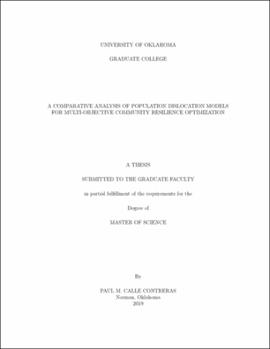| dc.contributor.advisor | Nicholson, Charles | |
| dc.contributor.author | Calle Contreras, Paul M. | |
| dc.date.accessioned | 2019-08-05T19:16:29Z | |
| dc.date.available | 2019-08-05T19:16:29Z | |
| dc.date.issued | 2019-08-01 | |
| dc.identifier.uri | https://hdl.handle.net/11244/321114 | |
| dc.description.abstract | The importance of community resilience has been demonstrated by the large amount of human and economic losses from hazard events worldwide. The ability of a community to be able to recover from an event of this nature is essential for
the continuity of its normal activities. Mitigation which is related with actions taking prior to a hazard event aim to decrease future consequences. Structural retrofitting is one way to diminish damage to buildings in case of an earthquake.
A Mitigation Resource Allocation (MRA) multi-objective optimization problem that decides which buildings to retrofit taking into account two objectives direct economic loss and population dislocation is studied. The case study is Shelby County, Tennessee. From literature, two population dislocation models are selected. Since it is not possible to determine that one population dislocation model is better than the other. The aim of this thesis is to explore the implications of using each population dislocation model in the MRA problem | en_US |
| dc.language | en_US | en_US |
| dc.subject | Multi-objective optimization | en_US |
| dc.subject | Community resilience | en_US |
| dc.subject | Population dislocation models | en_US |
| dc.title | A comparative analysis of population dislocation models for multi-objective community resilience optimization | en_US |
| dc.contributor.committeeMember | Mohebbi, Shima | |
| dc.contributor.committeeMember | Gonzalez Huertas, Andres | |
| dc.date.manuscript | 2019-07 | |
| dc.thesis.degree | Master of Science | en_US |
| ou.group | Gallogly College of Engineering | en_US |
| shareok.nativefileaccess | restricted | en_US |
